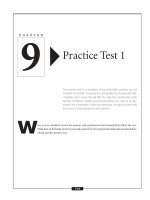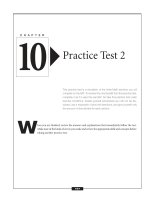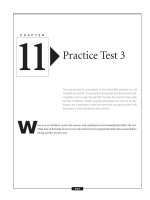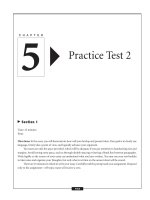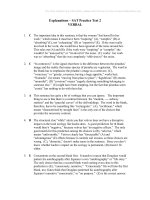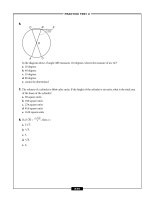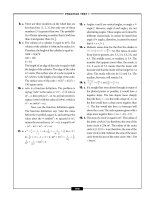Sat math essentials 2 docx
Bạn đang xem bản rút gọn của tài liệu. Xem và tải ngay bản đầy đủ của tài liệu tại đây (77.31 KB, 6 trang )
W
hether you bought this book, borrowed it, received it as a gift, took it out of the library, stole
it (not a good idea!), or are simply reading it in a book store, you’re undoubtedly hoping to ace
the Math sections of the SAT Reasoning Test. Well, you’ve come to the right place to get pre-
pared! This book provides answers to any and all questions you may have about the Math sections of the SAT. To
get the most benefit from the book, work through it from cover to cover. Every hour you put into preparing for
the SAT will pay off on test day. Here is a breakdown of what to expect in each section of the book:
Chapter 1 is an introduction to the SAT. It answers basic questions you may have about the exam.
Chapter 2 provides information about what to expect on the Math sections of the SAT and how best to
prepare for the SAT.
Chapter 3 is a math pretest. This test serves as a warm-up, giving you a flavor for the range of math ques-
tions found on the SAT. Answers and explanations follow the pretest.
Chapter 4 teaches strategies and techniques for acing the Math sections of the SAT.
Chapter 5 reviews concepts of numbers and operations and provides sample numbers and operations
SAT questions with explanations.
Chapter 6 reviews algebra and provides sample algebra SAT questions with explanations.
Chapter 7 reviews geometry and provides sample geometry SAT questions with explanations.
Chapter 8 reviews problem-solving skills and provides sample SAT word problems with explanations.
Chapters 9, 10, and 11 are Practice Tests 1, 2, and 3. These practice tests are similar to the Math sections
of the SAT. Answers and explanations follow the practice tests.
The Glossary provides definitions of all key math terms used in this book.
Introduction
v
What Is the SAT?
The SAT Reasoning Test is a standardized test developed by the Educational Testing Service for The College Board,
an association of colleges and schools. It contains questions that test skills in math, reading, and writing.
Why Take the SAT?
Most colleges require prospective students to submit SAT Reasoning Test scores as part of their applications. Col-
leges use SAT exam scores to help them evaluate the reading, writing, and math skills of prospective students. There-
fore, it is important to do your best on the SAT so you can show colleges what you are capable of accomplishing.
CHAPTER
Taking the SAT
1
1
Who Takes the SAT?
The SAT Reasoning Test is the most common stan-
dardized test that high school students take when
applying to college. In fact, approximately two million
students take the SAT each year.
Will My SAT Scores Determine
Whether I Get into College?
No. Your SAT scores are only one small part of any col-
lege application. In other words, your SAT scores alone
will not determine whether or not a college accepts
you as part of its student body. Let’s say that again, a lit-
tle louder: YOUR SAT SCORES ALONE WILL NOT
DETERMINE WHETHER OR NOT A COLLEGE
ACCEPTS YOU AS PART OF ITS STUDENT BODY.
Colleges look at individuals, not just test scores and
grades. They want fascinating, curious, motivated peo-
ple on their campuses, not a bunch of numbers.
When evaluating candidates, admissions officers
look at your academic performance, but they also look
at the rest of your life. What are your interests? How do
you spend your time outside of school? What are your
goals?
When you submit an application to college, you
should make sure it shows what makes you a unique
person. Colleges typically aim to fill their campuses
with a diverse group of individuals. Think about what
you can best offer to a college community. What are
your strong points? Do you excel in music, theater, art,
sports, academics, student government, community
service, business, or other areas? It doesn’t matter what
your interests are. It only matters that you have them.
Let your best qualities shine through in your applica-
tion and you can be confident that you are presenting
yourself as a strong possible candidate for admission.
So, don’t sweat the SAT. Getting nervous about it
won’t help you anyway. As long as you follow through
with your plan to prepare for it, your score can help you
become an attractive candidate.
When Do I Take the SAT?
The SAT is offered on Saturday mornings several times
a year. Your high school guidance office can give you a
schedule. You can also find a schedule online at
www.collegeboard.com. Please note that Sunday
administrations will occur the day after each Saturday
test date for students who cannot test on Saturday for
religious reasons.
How Many Times Should I Take
the SAT?
The number of times you take the SAT is up to you. You
may register and take the exam as often as you wish.
Most colleges will not hold an initial lower score against
you, and some will be impressed by a substantially
improved score, so taking the SAT twice or three times
with the goal of raising your score is recommended if
you think you can do better. However, some students
prepare hard for their first SAT and feel satisfied with
their initial score.
Regardless, you shouldn’t take the SAT more than
three times. Chances are your score will not change sig-
nificantly on your fourth test. If you are still disap-
pointed after your third score, your time, money, and
energy will be better spent on other parts of your col-
lege application.
But no matter how many times you have taken
the SAT, you’re smart to be using this book. The only
way to raise your SAT score is through preparation
and practice.
–TAKING THE SAT–
2
Where Is the SAT Given?
Many high school and college campuses host the SATs.
When you register, you will be given a list of sites in
your local area, and you can pick one that is comfort-
able and convenient for you.
Where Do I Sign Up for the SAT?
To sign up for the SAT, you can:
1. Register online at The College Board’s website:
www.collegeboard.com.
2. Get the SAT Registration Bulletin from your high
school guidance office. The Bulletin contains a reg-
istration form and other important information
about the exam. If you are retaking the exam, you
can also register by phone at 800-SAT-SCORE.
How Long Is the SAT?
The SAT takes three hours and 45 minutes. In addition
to the testing time, you will get two or three five- to ten-
minute breaks between sections of the exam. You will
also spend up to an additional hour filling out forms.
Overall, you can expect to be at the testing location for
about four and a half hours.
What Is Tested on the SAT?
The SAT has approximately 160 questions divided into
eight test sections:
■
three critical reading sections
■
two 25-minute sections
■
one 20-minute section
■
three math sections
■
two 25-minute sections
■
one 20-minute section
■
two writing sections
■
one 35-minute multiple-choice section
■
one 25-minute essay
Your scores on these eight sections make up your
SAT scores.
In addition to the core eight sections, there is one
unscored “variable,”or “equating,” section that the test
writers use to evaluate new questions before including
them on future SATs. Thus, you will actually complete
a total of nine sections on test day. But it will be impos-
sible for you to tell which section is the variable section:
It can be critical reading, multiple-choice writing, or
math, and it can appear in any place on the exam. So
although the variable section does not affect your SAT
score, you must treat each section as if it counts.
In What Order Are the Sections
Tested?
The writing essay is always the first section of the SAT.
The multiple-choice writing section is always the last
section. The remaining sections can appear in any
order.
How Is the SAT Scored?
SAT scores range from 600–2400. You can score a min-
imum of 200 and a maximum of 800 on each subject:
math, critical reading, and writing.
A computer scores the math questions. For the
multiple-choice math questions, the computer counts
the number of correct answers and gives one point for
each. Then it counts your incorrect answers and
deducts one-quarter point from the total of your cor-
rect answers. For the grid-in math questions, the com-
puter counts the number of correct answers and gives
one point for each. No points are subtracted for incor-
rect answers to the grid-in questions. If the score that
results from the subtraction is a fraction of a point,
–TAKING THE SAT–
3
Four Steps to Scoring
Math Questions on the SAT
For multiple-choice questions:
1. Correct answers are added: 1 point for each correct answer.
2. Incorrect answers are subtracted:
ᎏ
1
4
ᎏ
point for each wrong answer.
3. Your raw score is the result of adding correct answers, subtracting incorrect answers, and then
rounding the result to the nearest whole number.
For grid-in questions:
1. Right answers are added: 1 point for each correct answer.
2. Wrong answers receive zero points: No points are subtracted.
3. Your raw score is the total number of correct answers.
Once questions are scored, raw scores are converted to scaled scores, using an equating process.
4
your score is rounded to the nearest whole number.
Your raw score for the math sections is then converted
to a scaled score (between 200 and 800), using the sta-
tistical process of equating.
Math Score Reporting
The College Board will send you a report on your
scores. They will also send your scores to any schools
(up to four) you requested on your application. Col-
leges, naturally, are used to seeing these reports, but
they can be confusing to everybody else. Here’s how you
look at them:
You will see your scaled math score in a column
headed Score. There are also columns titled Score Range
and Percentiles College-bound Seniors. The informa-
tion in these columns can be useful in your prepara-
tions for college.
Score Range
Immediately following your total scaled math score,
there is a score range, which is a 60-point spread. Your
actual scaled score falls right in the middle of this range.
Based on experience, The College Board believes
that if you retake the SAT without further preparation,
you are unlikely to move up or down more than thirty
points within each subject tested. In other words, if you
scored a 550 in math on your first SAT, chances are you
won’t score less than 520 or more than 580 in math if
you take the exam again without any extra preparation.
For this reason, it presents your score within a 60-point
range to suggest that those are the range of scores that
you could expect to get on the SAT.
Keep in mind that The College Board believes
your score won’t change if you retake the SAT without
further preparation. With further preparation, such as
using this book, your score can improve by much more
than 30 points.
Percentile
Your score report will also include two percentile rank-
ings. The first measures your SAT scores against those
of all students nationwide who took the test. The sec-
ond measures your scores against only the students in
your state who took the test.
The higher your percentile ranking the better.
For example, if you receive a 65 in the national category
